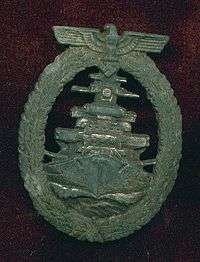High Seas Fleet Badge
| High Seas Fleet Badge Das Flottenkriegsabzeichen | |
|---|---|
|
design by Wilhelm Ernst Peekhaus | |
| Awarded by Nazi Germany | |
| Type | Badge |
| Eligibility | Military personnel |
| Awarded for | service in the Kriegsmarine High Seas Fleet |
| Campaign | World War II |
| Status | Obsolete |
| Statistics | |
| Established | April 1941 |
The High Seas Fleet Badge (German: Das Flottenkriegsabzeichen) was a World War II German military decoration awarded for service to the crews of the Kriegsmarine High Seas Fleet, mainly of the battleships and cruisers, but also those ships that supported them operationally for which there was no other award given.
Although the award was instituted in April 1941, it could be awarded for actions that took place prior to this date and could highlight the struggle against the British fleet.
Criteria for award
To be eligible to receive the badge one must have 12 weeks service on a battleship or cruiser, with proof of distinction and good conduct. The number of weeks were reduced if one of these conditions were met:
- If the recipient was wounded or killed during the voyage.
- Outstanding achievements in an engagement.
- If the cruise was successful.
- Individual's ship was sunk in action. (Bismarck, Admiral Graf Spee, Blücher)
- For participation in the sinking of HMS Rawalpindi by Scharnhorst and Gneisenau and the sinking of two merchant vessels south of Jan Mayen by Deutschland.
- All crew members of the Scharnhorst and Gneisenau received the award in view of the operational effectiveness of the ships.
- To every sailor who was present on the Tirpitz when it was bombed and sunk by the British R.A.F. in Tromsö Fjord on 12 November, 1944.
The award worn on the lower part of the left breast pocket of the naval service tunic, underneath the 1st class Iron Cross if awarded, or equivalent grade.
